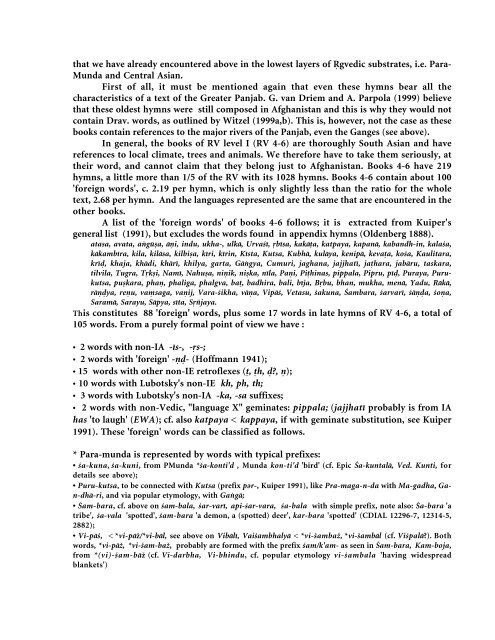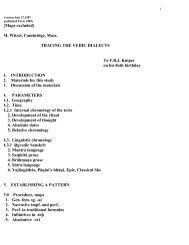The Languages of Harappa - People Fas Harvard
The Languages of Harappa - People Fas Harvard
The Languages of Harappa - People Fas Harvard
You also want an ePaper? Increase the reach of your titles
YUMPU automatically turns print PDFs into web optimized ePapers that Google loves.
that we have already encountered above in the lowest layers <strong>of</strong> gvedic substrates, i.e. Para-<br />
Munda and Central Asian.<br />
First <strong>of</strong> all, it must be mentioned again that even these hymns bear all the<br />
characteristics <strong>of</strong> a text <strong>of</strong> the Greater Panjab. G. van Driem and A. Parpola (1999) believe<br />
that these oldest hymns were still composed in Afghanistan and this is why they would not<br />
contain Drav. words, as outlined by Witzel (1999a,b). This is, however, not the case as these<br />
books contain references to the major rivers <strong>of</strong> the Panjab, even the Ganges (see above).<br />
In general, the books <strong>of</strong> RV level I (RV 4-6) are thoroughly South Asian and have<br />
references to local climate, trees and animals. We therefore have to take them seriously, at<br />
their word, and cannot claim that they belong just to Afghanistan. Books 4-6 have 219<br />
hymns, a little more than 1/5 <strong>of</strong> the RV with its 1028 hymns. Books 4-6 contain about 100<br />
'foreign words', c. 2.19 per hymn, which is only slightly less than the ratio for the whole<br />
text, 2.68 per hymn. And the languages represented are the same that are encountered in the<br />
other books.<br />
A list <strong>of</strong> the 'foreign words' <strong>of</strong> books 4-6 follows; it is extracted from Kuiper's<br />
general list (1991), but excludes the words found in appendix hymns (Oldenberg 1888).<br />
atasa, avata, agūa, åi, indu, ukha-, ulkå, Urvaśī, bīsa, kakåa, katpaya, kapanå, kabandh-in, kalaśa,<br />
kåkambīra, kila, kilåsa, kilbia, kīri, kīrin, Kīsta, Kutsa, Kubhå, kulåya, kenipå, kevaa, kośa, Kaulitara,<br />
krī, khaja, khådi, khårī, khilya, garta, Gågya, Cumuri, jaghana, jajjhatī, jahara, jabåru, taskara,<br />
tilvila, Tugra, Tki, Namī, Nahua, niik, nika, nīla, Pai, Pihinas, pippala, Pipru, pī, Puraya, Purukutsa,<br />
pukara, pha, phaliga, phalgva, ba, badhira, bali, bīja, Bbu, bhan, mukha, menå, Yadu, Råkå,<br />
råya, reu, vasaga, vaij, Vara-śikha, våa, Vipåś, Vetasu, śakuna, Śambara, śarvarī, śåa, śoa,<br />
Saramå, Sarayu, Såpya, sīta, Sñjaya.<br />
This constitutes 88 'foreign' words, plus some 17 words in late hymns <strong>of</strong> RV 4-6, a total <strong>of</strong><br />
105 words. From a purely formal point <strong>of</strong> view we have :<br />
• 2 words with non-IA -īs-, -s-;<br />
• 2 words with 'foreign' -- (H<strong>of</strong>fmann 1941);<br />
• 15 words with other non-IE retr<strong>of</strong>lexes (, h, ?, );<br />
• 10 words with Lubotsky's non-IE kh, ph, th;<br />
• 3 words with Lubotsky's non-IA -ka, -sa suffixes;<br />
• 2 words with non-Vedic, "language X" geminates: pippala; (jajjhatī probably is from IA<br />
has 'to laugh' (EWA); cf. also katpaya < kappaya, if with geminate substitution, see Kuiper<br />
1991). <strong>The</strong>se 'foreign' words can be classified as follows.<br />
* Para-munda is represented by words with typical prefixes:<br />
• śa-kuna, śa-kuni, from PMunda *ša-konti'd , Munda kon-ti'd 'bird' (cf. Epic Śa-kuntalå, Ved. Kunti, for<br />
details see above);<br />
• Puru-kutsa, to be connected with Kutsa (prefix pər-, Kuiper 1991), like Pra-maga-n-da with Ma-gadha, Gan-dhå-ri,<br />
and via popular etymology, with Gagå;<br />
• Śam-bara, cf. above on śam-bala, śar-varī, api-śar-vara, śa-bala with simple prefix, note also: Śa-bara 'a<br />
tribe', śa-vala 'spotted', śam-bara 'a demon, a (spotted) deer', kar-bara 'spotted' (CDIAL 12296-7, 12314-5,<br />
2882);<br />
• Vi-påś, < *vi-påž/*vi-bål, see above on Vibålī, Vaiśambhalyå < *vi-šambaž, *vi-šambål (cf. Viśpalå?). Both<br />
words, *vi-påž, *vi-šam-baž, probably are formed with the prefix śam/k'am- as seen in Śam-bara, Kam-boja,<br />
from *(vi)-šam-båž (cf. Vi-darbha, Vi-bhindu, cf. popular etymology vi-śambala 'having widespread<br />
blankets')

















